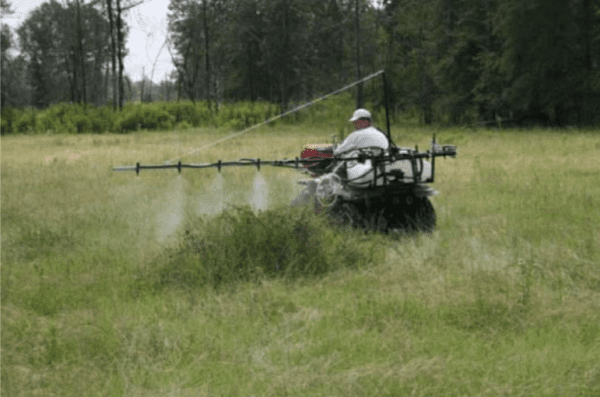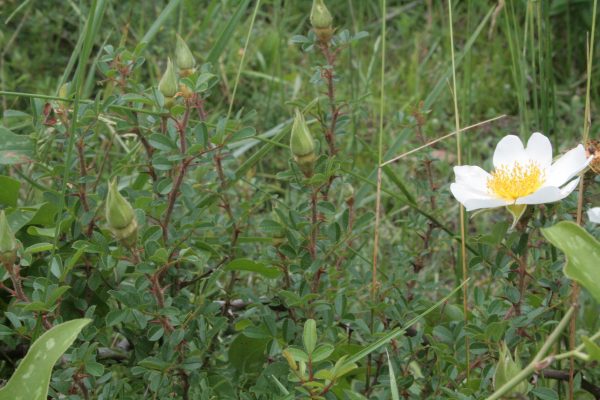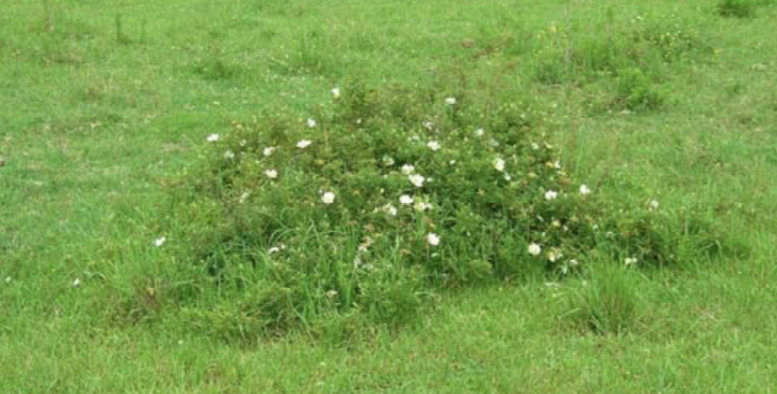Farming

Macartney rose (Rosa bracteata) is a troublesome perennial weed, especially in pastures where cattle strongly avoid grazing within or around the thorny stems. Macartney rose is similar to Cherokee rose (Rosa laevigata) as both have large, white solitary flowers. However, Cherokee rose leaves are generally alternately compound (three leaflets) and Macartney has five-to-nine leaflets. Both of these species are serious pasture weed problems in Alabama, but they are often more problematic on Blackbelt soils.
There has been little research on Macartney rose control since the early 1980s, and there are several new herbicides that have not been tested. In recent years, Alabama Cooperative Extension System professionals set out to to evaluate the efficacy of several of the newer herbicides on Macartney rose. The overall goal of this research was to develop a long-term management system for Macartney rose.
Methods
 In August 2009, a study was initiated on two pastures in Greene County near Eutaw, Alabama to evaluate the efficacy of seven herbicide products and mowing as means to control Macartney rose. These pastures contained a mixed forage of bermudagrass and bahiagrass and were actively grazed throughout the study. Individual rose clumps were categorized according to size based upon their estimated diameter (<1 m, 1 to 2 m, 2 to 3 m, and 3 to 4 m) and randomly assigned to herbicide treatments. Herbicides were broadcast applied to individual rose clumps with an ATV side-mounted boom sprayer at 35 gallons per acre.
In August 2009, a study was initiated on two pastures in Greene County near Eutaw, Alabama to evaluate the efficacy of seven herbicide products and mowing as means to control Macartney rose. These pastures contained a mixed forage of bermudagrass and bahiagrass and were actively grazed throughout the study. Individual rose clumps were categorized according to size based upon their estimated diameter (<1 m, 1 to 2 m, 2 to 3 m, and 3 to 4 m) and randomly assigned to herbicide treatments. Herbicides were broadcast applied to individual rose clumps with an ATV side-mounted boom sprayer at 35 gallons per acre.
A second study was initiated in March 2017 in a mixed-grass pasture in Lowndes County, Mississippi. The goal of this study was to evaluate the effectiveness of the relatively new herbicide product MezaVue. Established rose clumps of similar size were broadcast treated with a handheld boom sprayer at 20 gallons per acre.
In both of these studies, visual evaluations of herbicide efficacy were recorded at 11 and 13 months after treatment, respectively. The selected herbicide treatments represented several well-known, forage-labeled products used for herbaceous weeds and perennial woody vegetation that is often found along fencerows and in unimproved pastures.
Results
 Rose clump size did not significantly influence herbicide efficacy in either pasture. Although the herbicides performed differently between the two pastures, visual control has been averaged across both sites.
Rose clump size did not significantly influence herbicide efficacy in either pasture. Although the herbicides performed differently between the two pastures, visual control has been averaged across both sites.
MezaVue at 1.5 pints per acre was the most effective treatment from a late-March application. The next best treatments, respectively, were Grazon P+D at 8 pints per acre, Surmount at 4 pints per acre, Chaparral at 3.3 ounces per acre, and Milestone at 7 fluid ounces per acre when applied in August. Each of these treatments resulted in at least 30% control (table 1). Mowing provided no control as rose plants regrew and appeared more vigorous than the untreated controls.
These results suggest the active ingredient picloram has good activity on Macartney rose since it is found in the top three most effective treatments MezaVue, Grazon P+D, and Surmount. To use these restricted-use products, people must have a pesticide applicator license. Whether treating Macartney rose in late-March or August, it is important to ensure the following:
- the plants’ leaves are fully expanded
- the plants are actively growing
- the herbicide adequately covers the plant canopy with increased spray volume
These results indicate that Macartney rose is extremely difficult to control in pastures, and repeated treatment with effective herbicide product is necessary. Remember to read and follow all label directions prior to herbicide use.
Table 1. Average Visual Control From Broadcast Foliar Application of Forage-Labeled Herbicides*
*A non-ionic surfactant (NIS) was included at 0.25% volume per volume for all spray treatments.
| Treatment | Product Rate (per acre) | Average Control (%) |
|---|---|---|
| MezaVue | 1.5 pints | 70 |
| Grazon P+D | 8 pints | 36 |
| Surmount | 4 pints | 35 |
| Chaparral | 3.3 ounces | 32 |
| Milestone | 7 fluid ounces | 32 |
| GrazonNext | 2.6 pints | 30 |
| Grazon P+D | 4 pints | 28 |
| Chaparral+Remedy Ultra | 2.5 ounces + 1 pint | 25 |
| Surmount | 3 pints | 25 |
| GrazonNext+Remedy Ultra | 2.6 pints + 1 pint | 21 |
| Chaparral | 2.5 ounces | 20 |
| Cimarron | 0.5 ounces | 19 |
| Remedy Ultra | 1 pint | 11 |
| Remedy Ultra | 2 pint | 9 |
| Mowing alone | None | 0 |
Trade and brand names used in this publication are given for information purposes only. No guarantee, endorsement, or discrimination among comparable products is intended or implied by the Alabama Cooperative Extension System

